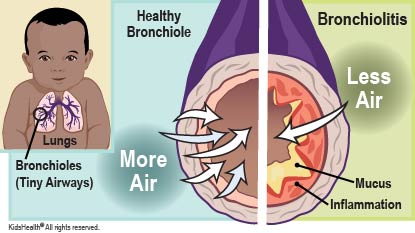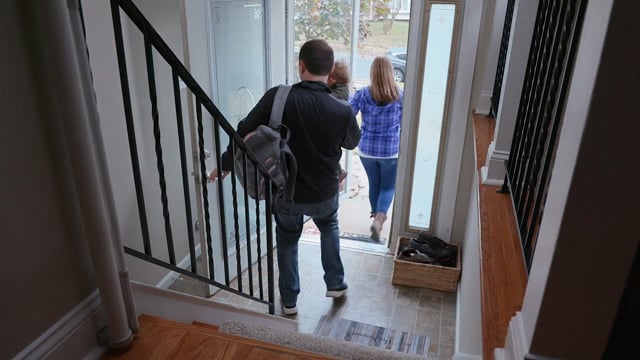- Parents Home
- Para Padres
- A to Z Dictionary
- Allergy Center
- Asthma
- Cancer
- Diabetes
- Diseases & Conditions
- Doctors & Hospitals
- Emotions & Behavior
- First Aid & Safety
- Flu (Influenza)
- Food Allergies
- General Health
- Growth & Development
- Heart Health & Conditions
- Homework Help Center
- Infections
- Newborn Care
- Nutrition & Fitness
- Play & Learn
- Pregnancy Center
- Preventing Premature Birth
- Q&A
- School & Family Life
- Sports Medicine
- Teens Home
- Para Adolescentes
- Asthma
- Be Your Best Self
- Body & Skin Care
- Cancer
- Diabetes
- Diseases & Conditions
- Drugs & Alcohol
- Flu (Influenza)
- Homework Help
- Infections
- Managing Your Weight
- Medical Care 101
- Mental Health
- Nutrition & Fitness
- Q&A
- Safety & First Aid
- School, Jobs, & Friends
- Sexual Health
- Sports Medicine
- Stress & Coping
Bronchiolitis
What Is Bronchiolitis?
Bronchiolitis (brong-kee-oh-LYE-tiss) is an infection of the respiratory tract. It happens when tiny airways called bronchioles (BRONG-kee-olz) get infected with a virus. They swell and fill with mucus, which can make breathing hard.
Bronchiolitis is more common during the fall and winter months. Most cases can be managed at home.

What Are the Signs & Symptoms of Bronchiolitis?
The first symptoms of bronchiolitis are usually the same as those of a cold:
Usually, symptoms get better on their own. But sometimes the cough might get worse and a child may start wheezing or have trouble breathing.
Bronchiolitis: When Should I Call the Doctor?
Bronchiolitis often is a mild illness. But sometimes it can cause severe symptoms. When it does, kids need treatment in a hospital to get fluids and, sometimes, help with breathing.
Call your health care provider if your child:
- develops a new or high fever
- has a cough or other symptoms that get worse
- is wheezing (a whistling sound heard with breathing)
Get medical care right away if your child:
- has trouble breathing. This may look like:
- fast, shallow breathing, when you see the belly moving up and down quickly
- your child is working hard to get breaths in. You may see the areas below the ribs, between the ribs, and/or in the neck sinking in with breathing.
- flaring nostrils
- lips or fingernails that look blue
- is very fussy and can't be comforted
- is very tired or won't wake up for feedings
- is not feeding well or is showing signs of dehydration, such as fewer wet diapers than usual
You know your child best. Call your doctor right away if something doesn't seem right.
What Causes Bronchiolitis?
Respiratory syncytial virus (RSV) is the most common cause of bronchiolitis. Sometimes, the common cold and the flu also can cause it.
Bronchiolitis:
- most often affects infants and young children because their small airways can easily get blocked
- is most common during the first 2 years of life, and especially among babies
- is more common in premature babies, children with lung or heart problems, and kids with weak immune systems
Kids who are around secondhand smoke have a higher risk for bronchiolitis. Older kids and adults can get bronchiolitis, but the infection usually is mild.
How Is Bronchiolitis Diagnosed?
When they suspect bronchiolitis, doctors listen to the child's chest and check oxygen levels with a pulse oximeter.
Usually, no tests are needed. The doctor may use a swab to get a sample of mucus from the nose for testing. This helps with identifying the type of virus causing the problem.
A chest X-ray might be done if the child's oxygen level is low or the doctor suspects pneumonia.
How Is Bronchiolitis Treated?
Most cases of bronchiolitis are mild and don't need specific medical treatment. Antibiotics can't help because viruses cause bronchiolitis. Antibiotics work only against bacterial infections.
Treatment focuses on easing symptoms. Kids with bronchiolitis need time to recover and plenty of fluids. Make sure your child gets enough to drink by offering fluids in small amounts often.
You can use a cool-mist vaporizer or humidifier in your child's room to help loosen mucus in the airway and relieve cough and congestion. Clean it as recommended to prevent buildup of mold or bacteria. Avoid hot-water and steam humidifiers, which can cause scalding.
To clear nasal congestion, try a nasal aspirator and saline (saltwater) nose drops. This can be especially helpful before feeding and sleeping.
Talk to the doctor before giving your child any medicine. For babies who are old enough, you may be able to give medicine to help with fever and make your child more comfortable. Follow the package directions about how much to give and how often. Do not give aspirin to children who have a viral illness. Such use is linked to Reye syndrome, which can be life-threatening. Babies and young kids should not be given any cough or cold medicines.
Is Bronchiolitis Contagious?
Viruses that cause bronchiolitis spread easily through the air when someone with an infection coughs or sneezes. Germs can stay on hands, toys, doorknobs, tissues, and other surfaces. People can be contagious for several days or even weeks.
How Long Does Bronchiolitis Last?
Bronchiolitis usually lasts about 1–2 weeks. Sometimes it can take several weeks for symptoms to go away.
Can Bronchiolitis Be Prevented?
Washing hands well and often is the best way to prevent the spread of viruses that can cause bronchiolitis and other infections.
Also:
- Keep infants away from anyone who has a cold or cough.
- Protect kids from secondhand smoke.
- Keep toys and surfaces clean.
- Talk to your child’s doctor about whether your child should get an RSV antibody shot and a flu vaccine.

Understanding Bronchiolitis
Understand what bronchiolitis is and how to care for your child at home.

© 1995- The Nemours Foundation. KidsHealth® is a registered trademark of The Nemours Foundation. All rights reserved.
Images sourced by The Nemours Foundation and Getty Images.